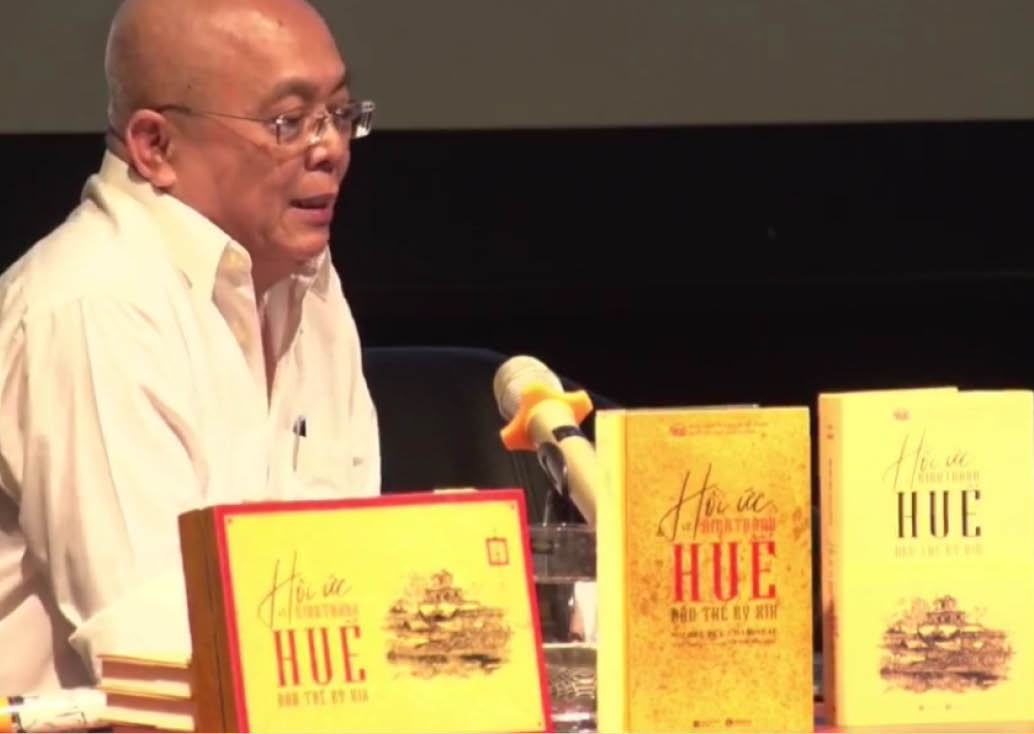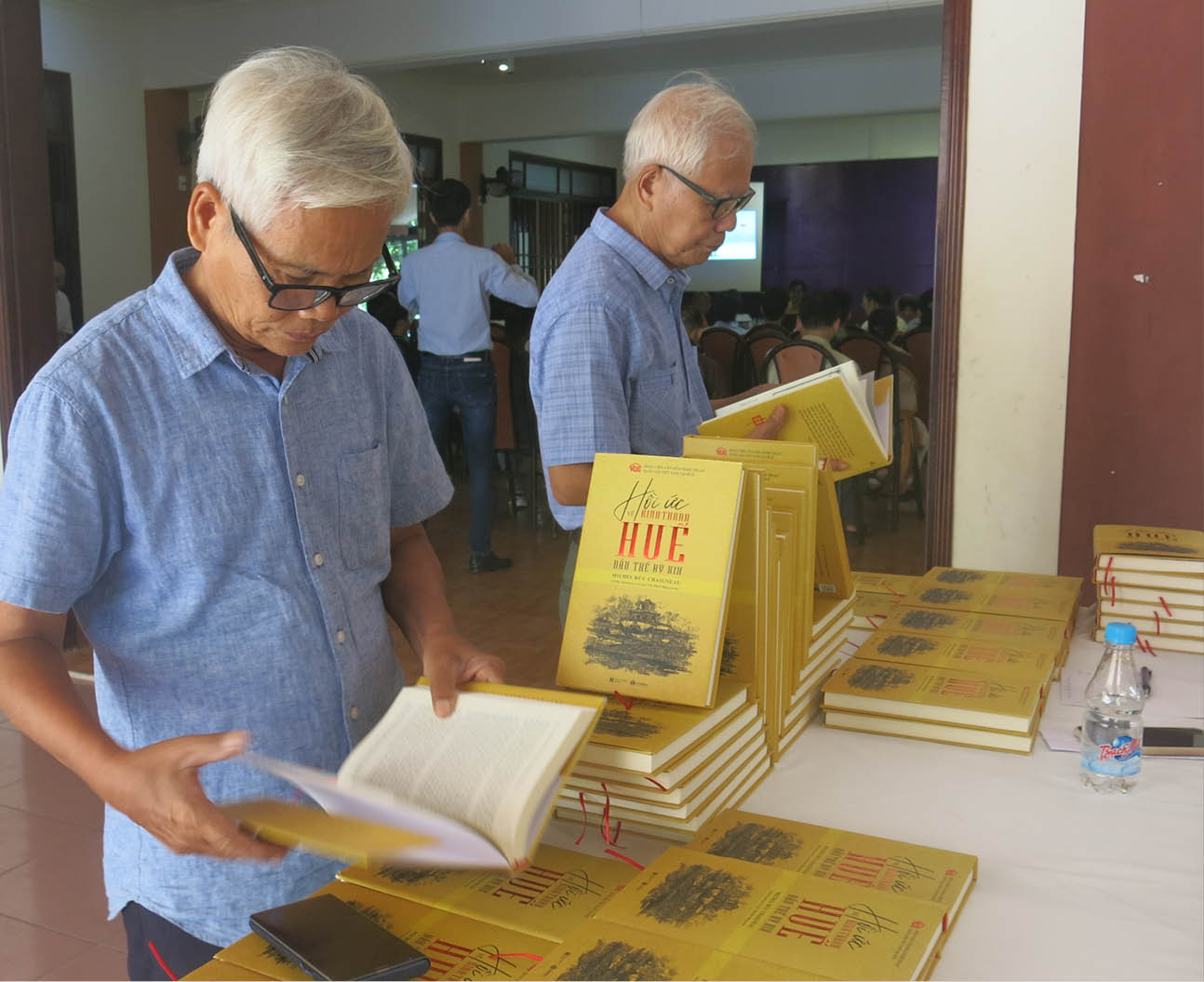
Le Duc Quang, the translator, introducing the book
The book, translated and annotated by Dr. Le Duc Quang, has just been introduced by the National Academy of Culture and Arts in Hue, giving readers access to a reliable document that has portrayed an image of ancient Hue.
Published in 1867, the scope of "Souvenirs of Hue Citadel in the early Nineteenth Century" is Hue imperial city, mainly inside and outside the two citadel walls that are now commonly called as the Citadel. The outer regions are all neighborhoods or nearby towns...
The book takes readers to every place of the city and surrounding areas, from the most important places not everyone can set foot on, such as: the palace, the forbidden palace, to the more everyday places where people live and do business, such as: Duoc market, Dinh market, Bao Vinh town... At each place, Michel Duc Chaigneau always added his personal comments.
The author also described meticulously specific activities in the capital, such as the Lunar New Year with many different scenes that portrayed a characteristic image of the New Year in the ancient capital. They include the scenes of the mandarins and the soldiers cleaning up and reorganizing the workplace; of the mausoleums being cared for; of the ancestor worshipping and family partying; of the setting off firecrackers and the New Year days’ games...

"Souvenirs of Hue Citadel in the early Nineteenth Century" gives readers a glimpse into the ancient imperial city appearance
The author captured each action and ritual in folk customs, each dish and taste, from Nam Giao sacrifice ceremony, Xa Tac sacrifice ceremony, Tich Dien ceremony, wedding ceremony, and ancestor worship on Tet holiday, to the boating scene on the Perfume River, the garden house of Hue, to the menu of a wedding party, a snack in the Hue family...
There were details carefully recorded by the author, such as the description of the Hue imperial city on the first day of the year: “In the morning of the beginning of the year, the mandarins dressed in great clothes will gather in the Imperial City: they line up and then go into the courtyard where the king granted audience... During the first day of the year, from the palace, to the houses of the mandarins or commoners, to express the joy of the New Year, people set off firecrackers. Everyone went on the street, some went for a walk, some went to the theater or watched acrobatics… ”.
The setting of the souvenirs was very limited, the author seemed to focus on the imperial city and surrounding areas. Therefore, the author's comments on An Nam society and people were limited to the Nguyen capital in the early 19th century, especially under Emperor Gia Long. But a glimpse that was highly focused on the land of the Capital of Mysteries provides the reader with a unique socio-cultural map, with amazingly accurate details.
Michel Duc Chaigneau (1803-1894) was the son of a French official and a Hue woman, born and raised in Hue in the first 20 years of the 19th century, during the reign of Emperor Gia Long and the first 5 years of the reign of Emperor Minh Mang. The author was a witness in a unique place: as an insider and outsider of a cultural space. This is one of the valuable features of "Souvenirs of Hue Citadel in the early Nineteenth Century".
The translator Le Duc Quang said that the author was in a strange position and it is fortunate for us that he took his time to recount his "normal" days, the days traveling here and there in the capital and surrounding areas, to "unusual" moments in his life: meeting Emperor Gia Long, Queen and Emperor Minh Mang.
“The souvenirs paint a vivid picture of Hue imperial city during the reign of Emperor Gia Long; each page is a “snapshot” of contemporary Vietnamese people and society. The author takes the reader through many different regions and spaces, from Ngo Mon Gate to Tam-Phap to the trials, from the common market scene to the scene of the market crowded with sellers and buyers, from the scene where people went shopping to that of special local dishes,” emphasized the translator Le Duc Quang.
Readers will many times witness the "culture shock" from a person with both French and Vietnamese blood, who grew up in a very special cultural environment: the court, the mandarins of the Nguyen Dynasty with all special activities, rituals and languages.
According to Dr. Tran Dinh Hang, Director of the Vietnam National Academy of Culture and Arts in Hue, with the desire to contribute an evidence and a perspective, the Vietnam National Academy of Culture and Arts in Hue chose an approach to Hue as the capital of Dang Trong (the Inner Realm), then the capital of Dai Nam in the Nguyen Dynasty - and from the French, from the French documents, or expanding further to the Western sources...
"Souvenirs of Hue Citadel at the early of the Nineteenth Century" by Michel Duc Chaigneau is a fairly complete and interesting recollection of Hue imperial city closely linked with the story of the French-Vietnamese fate, notably beginning from the 18th -19th centuries.
Story and photos: MINH HIEN